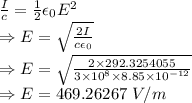
Physics, 03.12.2019 05:31 Gearyjames8
We can reasonably model a 90-w incandescent lightbulb as a sphere 7.0cm in diameter. typically, only about 5% of the energy goes to visible light; the rest goes largely to nonvisible infrared radiation.
a) what is the visible light intensity at the surface of the bulb?
b) what is the amplitude of the electric field at this surface, for a sinusoidal wave with this intensity?
c) what is the amplitude of the magnetic field at this surface, for a sinusoidal wave with this intensity?

Answers: 3
Another question on Physics

Physics, 22.06.2019 14:30
Which of the following changes will increase the capacitance of a parallel-plate capacitor? (there could be more than one correct choice.) a) increase the charge on the plates b) decrease the poten5al between the plates c) increase the potential between the plates d) introduce a dielectric material between the plates e) decrease the separation between the plates
Answers: 3

Physics, 23.06.2019 02:50
You are still fascinated by the process of inkjet printing, as described in the opening storyline for this chapter. you convince your father to take you to his manufacturing facility to see the machines that print expiration dates on eggs. you strike up a conversation with the technician operating the machine. he tells you that the ink drops are created using a piezoelectric crystal, acoustic waves, and the plateau-rayleigh instability, which creates uniform drops of mass m = 1.25 ✕ 10−8 g. while you don't understand the fancy words, you do recognize mass! the technician also tells you that the drops are charged to a controllable value of q and then projected vertically downward between parallel deflecting plates at a constant terminal speed of 20.0 m/s. the plates are ℓ = 2.15 cm long and have a uniform electric field of magnitude e = 6.40 ✕ 104 n/c between them. noting your interest in the process, the technician asks you, "if the position on the egg at which the drop is to be deposited requires that its deflection at the bottom end of the plates be 0.17 mm, what is the required charge on the drop (in c)? " you quickly get to work to find the answer. (neglect the force of gravity.)
Answers: 1

Physics, 23.06.2019 03:30
First to answer will be the brainliest i need the answer asap
Answers: 1

Physics, 23.06.2019 04:31
You have 80 g of 60oc water and 80 g or 10oc water. what is the final temperature when the two are mixed? explain.
Answers: 2
You know the right answer?
We can reasonably model a 90-w incandescent lightbulb as a sphere 7.0cm in diameter. typically, only...
Questions

Chemistry, 17.11.2020 14:00


Chemistry, 17.11.2020 14:00

Mathematics, 17.11.2020 14:00

Social Studies, 17.11.2020 14:00




Mathematics, 17.11.2020 14:00



Chemistry, 17.11.2020 14:00



Social Studies, 17.11.2020 14:00

Mathematics, 17.11.2020 14:00


Chemistry, 17.11.2020 14:00




 = Permittivity of free space =
= Permittivity of free space = 








